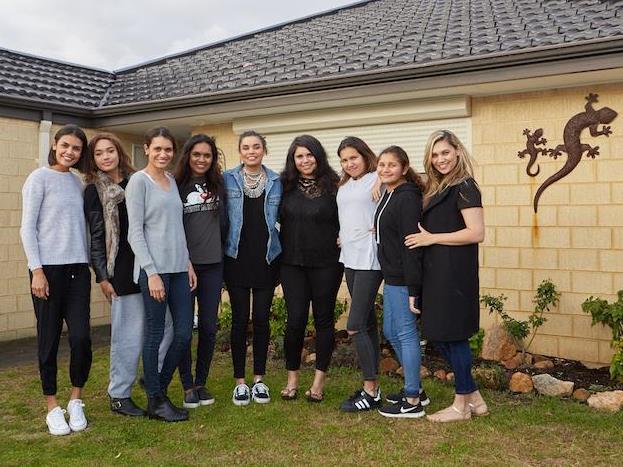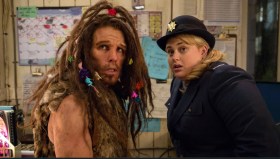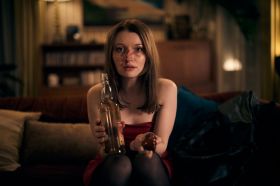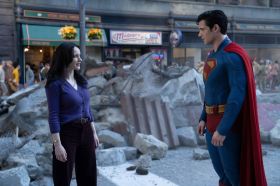Image: My Family Rules, shot by Sabine Alders.
Once broadcasters realised that audiences love intimate true life stories, the small world of observational documentary came under tremendous pressure. The networks wanted cliffhangers, heroes and villains, always called ‘strong, compelling stories’. Producers were told to set the action up, to contrive, to turn people into parodies of themselves.
Many crews are confident they can nudge the action around and stay true to an honest vision of people and situations. The lines can be pretty blurred, and the deep history of documentary is based on recreation and repetition. But other, more indy creators don’t like this slippery slope at all.
Series Producer Gillian Moody is a Wodi Wodi woman from Wreck Bay on the South Coast of NSW, who has been working with Indigenous filmmakers through SBS, NITV and Screen Australia for over twenty years. She was inspired originally by Uncle Lester Bostock and a program at the Australian Film Television and Radio School.
When she came onto the proposal to make six half hours about the Indigenous Rule family in Western Australia, she knew she was walking on a fragile land. It would be easy to create a caricature, to get tangled up in White ignorance, to pander to prejudice.
Moody had no doubt about where she stands. ‘I don’t like the term reality TV,’ she said. ‘We call it a deep access observational series rather than reality TV. The daily lives of the family actually drove our stories and the episodes, and we were trying not to be really constructed.’
The original idea came from a series which SBS created in a deal with ScreenWest called From the Western Frontier. One episode, called Angela’s Rules, featured a rising Aboriginal Australian singer and songwriter, with glimpses of another eight sisters and her extraordinary mother, Daniella. It is still on SBS catch-up.
The writer-director was Karla Hart, herself a pretty remarkable Noongar woman, who had been making short documentaries, acting in theatre, managing and performing in the dance group Kwarbah Djookian and co-ordinating the Wardanji Festival. And she sings and has a radio show.
The series producer for From the Western Frontier was Renee Kennedy, an independent producer of one hour docs and a former supervisor of production at Beyond Screen Production.
The two packaged and presented the idea of an eight part half hour series on the family, called Family Rules, to NITV through Kennedy’s company Metamorflix.
For NITV this is a perfect fit. This is the tenth anniversary of the channel, and channel manager Tanya Denning-Orman wants to celebrate the survival story and present flagship works which announce their ambition for the future.
‘A lot of NITV is about inspiration and pride,’ she explained in an email. ‘And for us, it was really important to have a series that was real and just showed us: Aboriginal and Torres Strait Islander people. When I was growing up, I didn’t see “us” in anything. The ambition with the channel is so young people can see us for pride, and elders can see us for pride and just not be invisible in their own country.
‘This series is a factual, observational series that is heartwarming, but entertaining. It really reflects this new era of NITV.’
According to Moody, ‘The idea was to be able to show a unique, extraordinary Indigenous family and their everyday life, being unashamedly who they are. They are not trying to be anybody else, they just want to live their lives and dream big.
‘I rarely saw Aboriginal people on screen when I was growing up and when I did it was always in drama or negative news stories. It was very much a thing for me, to show the normality of life. To be not constructing it. Just telling it as the truth.’
‘A lot of documentaries have been made from an outside looking in POV and the real thing about having Indigenous Aboriginal creative involvement on productions is that you get a perspective from within as well.’
It is traditional to pitch observational series in terms of powerful stories and deep conflicts. Who wins and loses? Who has the highest stakes? Who is the central character? But this is a story of success, of single mother Daniella Borg who is raising nine daughters. The older kids have their own families, but three of them are still at home in a constant whirl of domesticity and low key excitement. Is it possible to build six compelling episodes out of ordinary, meandering family life?
But the shapelessness is an illusion. Every family has fixed rituals and climaxes. ‘We knew Aleisha was in her final year of school so the school ball would come up,’ said Moody.
‘Shenika for example had just had her second child. Modelling is her career. So we knew during that six months she would have a break and be thinking about getting back to work. What was it going to be like raising her two boys? Sharna decided to leave the family nest, and moved in with her sister Kelly. Angela the eldest had only just given birth. So we knew there would be a lot of new experiences for her being a first time mother and and would want to talk to her mum about it. They are such a supportive family for each other – they really always ask each other’s advice and value each other’s advice.’
Rather than focus on conflict, the team was tracking choices and aspirations – the ‘dreaming big’ which they all share in their different ways. They also followed the humour, because it showed them the small, daily clashes in the family and how they were resolved.
‘We had a very open dialogue with Daniella which allowed us talk through life events and dreams that she had or wanted to share with her girls’, said Moody. With this kind of access, they found a powerful underlying drama about heritage and family. Encouraged by the film, the family acted on an idea to go back to visit Nan Winnie, a cousin of their grandmother in her own country, to connect with the intense female reality and traditional experience they lived out every day.
Beneath the various story arcs was the murmur of their missing father. Kevin was killed in a random attack in 2004.
‘We also knew that one of the angles we wanted to explore was about their father and what he meant to them and what his death meant to them’, said Moody. ‘This is a family which has been through a really traumatic death. Some of the kids didn’t know their dad. Hannah was only five weeks old when he died.
‘The girls are still always discovering something new about him. The older girls are telling the younger girls. Their mum is telling them. Go to his country – Norseman.’
So, as a family, they did just that, to pull the strands of the film together in a climax which binds the stories of family and culture, dreams and heritage together.
The film was shot between January and September over 83 days. While all the kids and Danielle and the extended family were constantly in and out of each other’s lives, the rhythm of the shoot was really set by the school. Danielle is the Aboriginal Indigenous Education Officer at the same school which the three youngest children attend, so the house is empty during the day.
The shooting climaxes occurred in holidays, which were also the times to go bush. The crew had two shooter-directors in Karla Hart and Claire Leeman, with a separate DOP. Murray Lui came in from the east coast for the key blocks and was joined by Jim Frater for the away shoots. Between these bigger events, Hart and Leeman continued to shoot the small dramas and daily lives.
‘We had two to three cameras on each day,’ said Moody. ‘We very quietly spent the first couple of weeks shooting with the family so they could get used to the camera and the sound guys as well. We assigned family members to Karla and to Claire, to keep up to date with the family members finding out anything special we should be with them for.
‘That made the whole process a lot easier. So I could talk to Karla or Claire to find out about a particular person. It helped with the scheduling. We constantly had bigger production meetings in the storyroom so we could all be across what is happening’. ‘Any story thread could play out or arise on any given day.’ ‘You never really just got one person, for example if you just wanted to be with Daniella and one sister, this was rare as there is often others in the home or popping by for visits, so we all needed to be alert.’
Between January and May they did no editing. Instead, they were all watching daily rushes shot on two or three cameras. And they were logging. Moody did it. A production assistant in the office did it. The field directors helped as well. ‘Both Claire and Karla were logging rushes as well, they were not on location every day but were often with the family at least three or four days a week. If they weren’t shooting they were logging so we had a very detailed record.’
On top of that, they created daily field and editing notes, so they always knew how each shoot fitted into the whole. The whole production was tracked on master daily progress reports. Effectively that turned the detailed logs into the raw material for stories, so the footage could be cleanly allocated to editors, who only dealt with relevant footage.
There were major monthly script meetings and a lot of discussion in between, in which they constantly asked and noted what had been shot, what had been missed, and what was happening next. They trained themselves to watch for subsidiary characters who could be evolving their own stories or who could take centre stage if a strand went sideways. They were hunting endlessly for the stories that would eventually underpin each episode.
The detailed logs were vital. They didn’t have to scrabble back through the rushes looking for half-remembered scenes, and could find all the element of a particular story across months by typing a couple of key words.
A lot of hard line reality TV shows are cutting very fast, creating the scenes immediately after they have occurred. That means the post team manages lots of angles but the material is all recent and easier to remember.
The decision to start cutting a long way into the shoot disconnects the two processes. While it means the stories can be built around much subtler beats, and can run over months, it creates a ferocious memory problem.
As Moody remembers, ‘For the first forty days I had everything in my head. After that, I couldn’t retain it any more, and I had to go back to the logs to see what day that was.’ Without meticulous logs, editors can find themselves hunting through old scenes to find fragments, and discovering they didn’t even exist in the first place.
The series post production director was Claire Forster. She and Moody supervised three edits each, with three editors, David Fosdick, Roland Smith and Meredith Watson Jeffrey, each doing two episodes over fourteen weeks. ‘We scripted them up through monthly session, to work out what we had and what we still needed so we had a reasonably clear idea of each episode when they went into the edit.’ The entire post production took 25 weeks.
They also decided to use interviews as voice over, and dump the traditional voice of god narration. During the major blocks of filming Moody shot master interviews with everyone, while the shooter-directors caught them with questions as the days unfolded.
‘We had an idea of what we had to learn from the family. Some of the early interviews we asked them their thoughts and ideas. Then we became more specific on story threads and particular information we needed. We were very aware we had a mother and nine daughters and people would not remember who we were talking about.’
Used carefully, the master interviews deal with larger reflections about the family, and set up expectations about future actions. The running interviews are anchored firmly in the present. This enabled them to deal with the ‘tense problem’, cutting out the clash between remembrance of the past and descriptions of contemporary action. That kind of mess tempts directors to pretend that the past has not yet occurred.
In a way, the series is part of SBS’s drive to remain relevant and command attention through the hazy sports-mad months of summer. It launches at 7.30pm on Monday 9 January and then strips onto the same slot on Tuesday and Wednesday, before repeating the trick on the week of Monday 16 January.
I really hope it breaks out beyond its enthusiastic Indigenous audience. As executive producer Renee Kennedy said in her statement for the media kit,
The size of this family, the fact that they are all girls – all born to the same mother and father – is a rarity in a society filled with nuclear and broken families. What makes the Rule children so intriguing is that they are representative of young Australia – aspirational, media savvy, tech literate, opinionated and thoughtful – and that they allow us to see this aspect of our society from the perspective of Indigenous Australians. They are proud of their Noognar and Ngadju heritage and always mindful of supporting their community in their daily endeavours.
I hope that this series will mark an important milestone for Australian television. Rarely has an urban Indigenous family opened their doors to Australia in this way. This is not Redfern or Western Sydney; it is not the remote Northern Territory or the Kimberley, but an unassuming suburb 12 kilometres east of Perth. So what happens here, with this family, is all the more important because this story has never been told.





